How and how to feed hydrangea correctly?
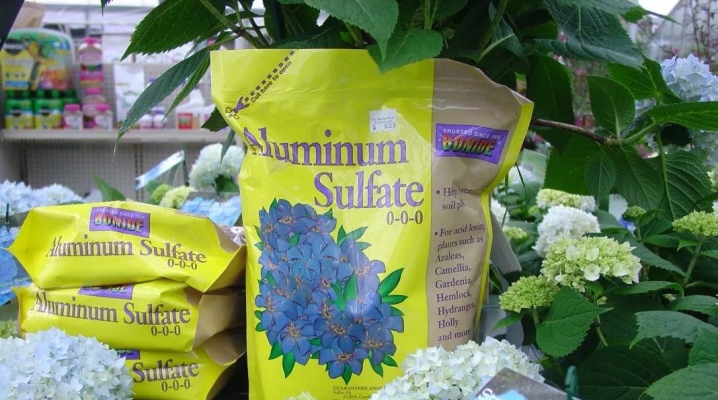
Hydrangea is not the most whimsical plant that even a beginner in gardening can handle growing. However, in some situations, for example, in case of illness or lack of vitamins, even it requires feeding.
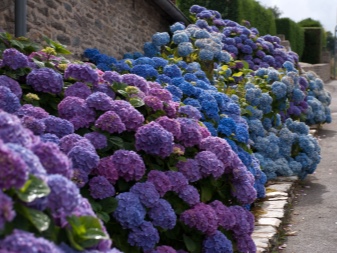
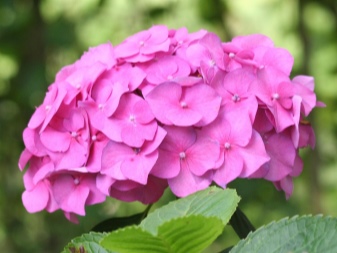
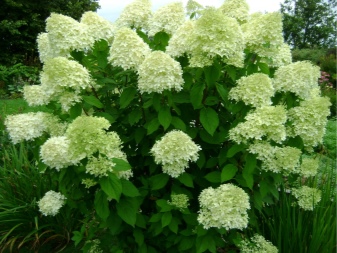
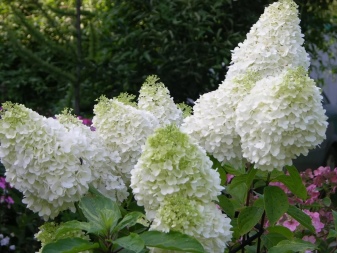
What problems can you solve?
Absolutely anyone who knows the basic rules of caring for plants can grow a hydrangea in a garden or at home. And here how to make the hydrangea bloom profusely, do not hurt and generally please the eye - not everyone already knows... The flower needs regular watering and moist soil, and in case of illness or adverse weather conditions - top dressing. During the growth of a flower, a variety of problems arise, some of them are solved with the help of feeding.
So, with dull, as if "overexposed" leaves with a yellowish tinge, it is necessary to use fertilizers with nitrogen - it is its lack that provokes the unhealthy color of the leaves. If there is no opportunity to purchase special fertilizers, you can use ordinary ammonia, which contains a large amount of ammonia and can act as a nitrogen substitute.
To do this, make a solution from a bucket of warm water and 2-3 tablespoons of ammonia. After that, the resulting liquid is poured into a spray bottle or a special hose, the hydrangea is sprayed from top to bottom. If the plant is in no hurry to recover and retains pale leaves, then a similar procedure is repeated after 14 days.


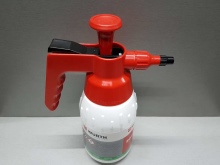
Another reason for the discoloration of leaves is chlorosis. This is a disease in which the plant lacks iron. In this case, a solution is made from ferrous sulfate and ferrous sulfate. Each component is purchased in powder, after which 7 grams of each are measured and diluted with a liter of warm water. This procedure must be repeated two times - the second time the hydrangea is sprayed after 10 days.
Nitrogen fertilizers can also be used if the hydrangea does not grow well. Nitrogen promotes healthy growth of young branches and the formation of lush foliage in the shrub. But be careful with nitrogen fertilization - too frequent use of it can lead to an excessive set of vegetative mass (the number and mass of leaves), which in turn will take away some of the nutrients from the buds, which means that the flowering will be sluggish and weak. If the leaves brighten, but do not turn yellow, but simply lose their rich green color, turn pale, you should pay attention to supplements with nutrients, among which slurry and urea must be present. It is necessary to use these make-ups according to the instructions attached to them.
You can feed hydrangeas for lush flowering in the garden with phosphorus, potassium and magnesium.
Phosphorus is responsible for how many buds will bloom on each bush, what size they will be, how long they will bloom. Potassium is most important in the bud formation phase. The more magnesium, the richer the color of the inflorescences will be.

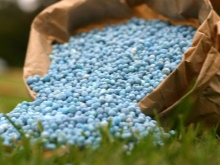

Fertilizer options
The number and variations of fertilizer formulations are very large, and new compounds are still being discovered that can affect the plant in one way or another. But currently preferred chemical fertilizers... A little earlier, when it was impossible to buy various additives in a specialized store, but only to make it with your own hands, most of the fertilizers were organic.Some of them are still in use today.
Organic
Chicken droppings, more precisely, an infusion of chicken droppings, is a fairly common fertilizer. It is diluted with water several times before use. First, a kilogram of droppings are diluted with twenty liters of warm water, and after receiving a concentrated solution, it is diluted with water again, but in a ratio of 1: 3. Infusion of cow dung is also diluted twice. The first time a kilogram of manure is poured with 10 liters of water, and then each liter of concentrate is diluted with two more liters of water.
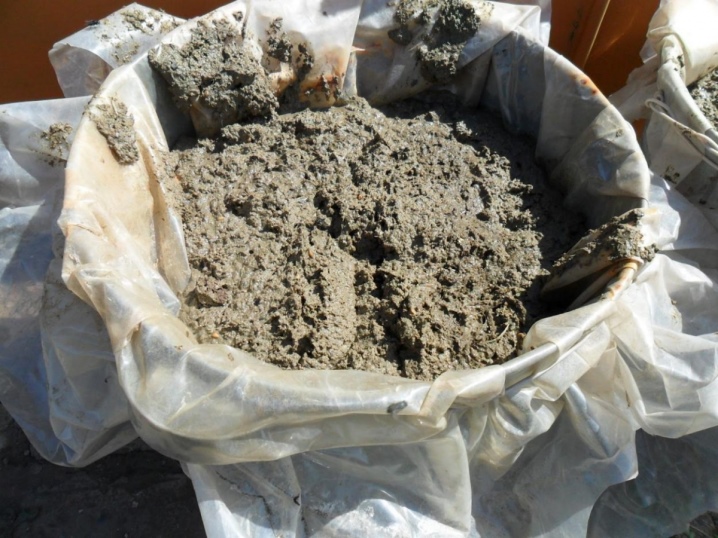
Organic fertilizers include kefir and other fermented milk products., which are not only good additives in themselves, but also act as acidifiers, which is very good for hydrangea, because its growth is associated with soil acidity, and the higher the acidity, the better the hydrangea grows. Yeast has similar properties, more precisely, yeast infusion. However, when using foodstuffs, make sure there is no salt in them, as this is harmful to the soil and plant. Potassium permanganate is also a good addition. In order not to burn the plants, it is necessary to feed them with a pinkish infusion. Potassium permanganate will make the shoots stronger and more flexible, give strength, increase the inflorescences and extend the flowering time.
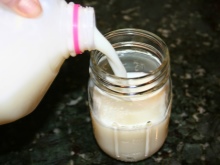

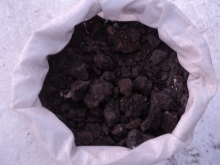
As mentioned above, hydrangeas are plants that prefer to grow in acidic soil. In an alkaline environment, they can hurt a lot and practically not absorb fertilizers. To prevent this from happening, it is necessary to periodically acidify the soil. This can be done with citric acid solution, apple cider vinegar solution, or slightly acidic electrolyte solution. Additionally, iron chelate, also known as ferrous sulfate, can be added to any of these solutions. This will help avoid chlorosis in the future.
Use organic fertilizers such as wood ash or dolomite flour with caution. - these substances reduce the acidity of the soil, which leads to the fact that the plant absorbs fertilizers worse, and also a decrease in acidity can change the color of the inflorescence.
Urea is a mineral fertilizer, so care must be taken that the plant does not accumulate excess salt deposits. This will lead to a violation of the hydrangea's metabolism, the flower will get sick.
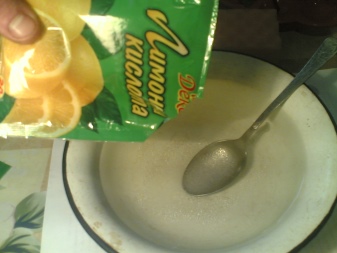
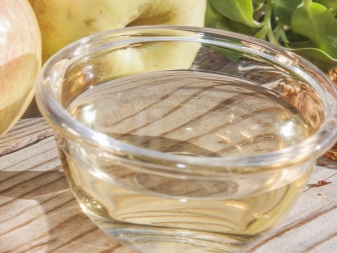
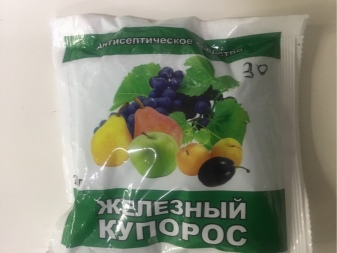
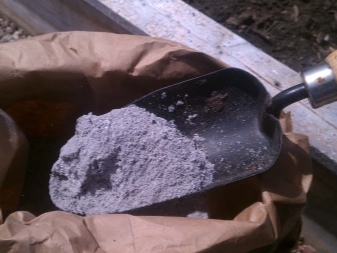
If you purposefully decide to change the color of your hydrangea, then this can be done by changing the acidity of the soil. To do this, you can start using alum - you need to water the plants with a solution of aluminum-potassium alum. This will significantly reduce the amount of acid in the soil and turn the pink buds into blue ones. Do not forget that in terms of their effectiveness, organic fertilizers cannot be compared with specially developed formulations that already contain all the necessary components.
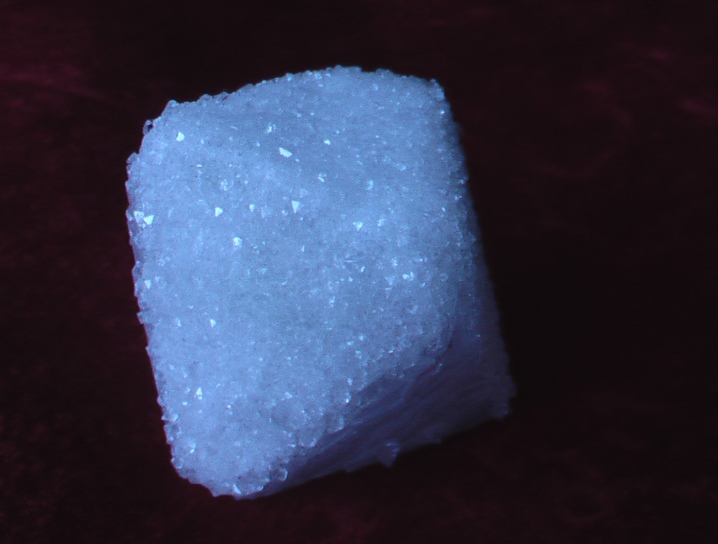
Industrial
Industrial (chemical) fertilizers are generally more effective. Despite the fact that some gardeners have prejudices against such formulations, industrial fertilizers are very useful, as they contain all the necessary sets of micronutrients. The only rule when using them is to strictly follow the instructions. There are a lot of varieties of industrial fertilizers, we will give the most useful for the growth and flowering of hydrangeas: "Fertika Kristalon for hydrangeas", "Agricola" for hydrangeas. The next industrial fertilizer Bona Forte "Fertilizer for blue hydrangeas" can change the color of the inflorescence.
If you are not planning on changing the color, use it with caution.

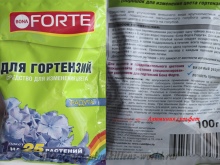
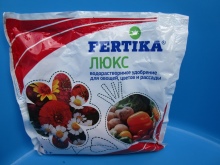
Timing
Each feeding has its own specific time. This is due to the fact that the different elements contained in the supplements are responsible for the different life processes of the hydrangea. And also, having received all the necessary substances, the hydrangea will be more resistant to the variability of weather conditions, diseases, pests and other stresses (for example, transplanting).Before feeding the plant, you need to remember if you added any fertilizer to the hole when planting the plant. If so, then the hydrangea does not need additional feeding for the next couple of years.
In the spring, it is necessary to feed the plant with those trace elements that are needed for the phase of active growth. These include: nitrogen, phosphorus, potassium, magnesium, iron. Nitrogen is responsible for the set of vegetative mass. Lack of phosphorus will be expressed in frail and expressionless flowering. Potassium is a versatile element that can be added to complementary foods in both spring and fall. In spring feeding, it is responsible for high-quality flowering. The brightness of the inflorescences and the formation of buds depend on magnesium.
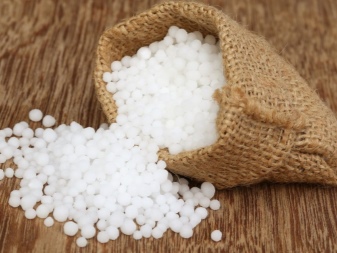

The first feeding of the plant occurs when the snow melts and the first shoots of grass appear. This usually happens in May or late April. The first feeding should consist of nitrogen-containing fertilizers. This is ammonium nitrate or urea. If you wish, you can use organic fertilizers, but their effectiveness is much lower. Potassium and phosphorus can be used with nitrogen supplements.
It happens that you forgot or missed the first feeding. There is nothing wrong with that, the main thing is to add a little more nitrogen during the second feeding. If you missed the second feeding, this is also not a reason to be upset. Some summer residents do not feed hydrangeas at all and, despite this, they grow well. You should not completely exclude nitrogen from feeding - it is he who helps the plant in the formation of new stems and leaves.

The second feeding should be in July, during the budding period. More often than not, most gardeners only do one top dressing. - just when the buds are forming. They immediately provide the plant with a full range of essential nutrients and trace elements. However, the main thing here is not to overdo it, so such things should be left to more experienced gardeners.
During the second feeding, the emphasis, on the contrary, shifts towards phosphorus and potassium, since they affect the state of the buds. Very little nitrogen is required to maintain the overall appearance of the plant. Excess nitrogen can lead to the fact that the vegetative mass will pull over most of the nutrients, preventing the buds from forming and opening properly. And also, an excessive amount of nitrogen will lead to the fact that the hydrangea will simply "drive the foliage", not allowing the leaves to fully live their life cycle, forming new ones all the time. As a result, the leaves will become weaker, and the plant itself will begin to wither.
Top dressing directly during flowering occurs at the request of the gardener in order to extend this period for as long as possible. The accent does not change during flowering, potassium and phosphorus are considered the most necessary.
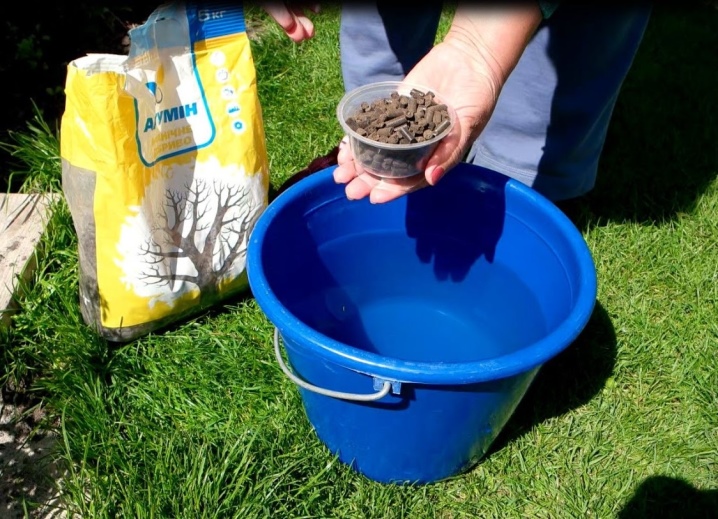
The very last feeding takes place in the fall to prepare the hydrangea for the long wintering period. Its goal is to allow the plant to accumulate as much nutrients as possible so that next year the awakening and formation of new buds will occur as soon as possible. In this regard, potassium comes out on top, followed by phosphorus. We begin to gradually remove nitrogen from the dressings immediately from the beginning of August and completely remove it from the composition by the fall, since it is responsible for the formation of new branches, which is absolutely not useful in winter. Conversely, the amount of potassium increases, since it is responsible for the formation of a strong root system, and the stronger and longer the roots of the plant, the better the plant will survive the winter when the amount of nutrients in the soil is minimal.
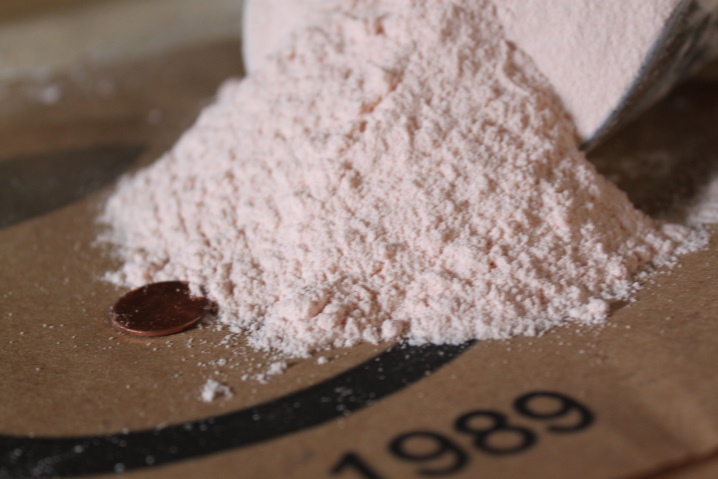
Proportions and feeding scheme
There are general recommendations for feeding hydrangeas, on which not only the assimilation of nutrients depends, but also the avoidance of possible injuries from the chemical elements contained in the supplements. Before feeding, the plants need to be watered with plain water. All fertilizers, especially mineral fertilizers, are added only to wet soil.You need to prepare for feeding in advance - a few days before the planned feeding, you need to thoroughly shed the earth around the hydrangea. Top dressing always takes place either in the early morning or in the evening, when the sun has already gone down. If the weather is cloudy and the scorching sun is hidden behind clouds, then feeding can be done at any time.
Top dressing is divided into foliar and root. Foliar dressing is, for example, spraying. It is believed that foliar dressing is most effective when illness or lack of vitamins affects mainly the appearance of the plant (with chlorosis). But remember that even a few foliar dressings cannot replace one root dressing, when all the nutrients go directly to the roots of the plant, and spread from the roots to the most necessary places at the moment.
It should be remembered that all dressings, including organic fertilizers, are made strictly according to the instructions. Mineral fertilizers such as urea and ammonium nitrate are always diluted with 10 liters of water. Urea is added 10–20 grams per 10 liters, and nitrate - 15–30 grams. In order not to dilute each mineral supplement separately, you can use special mineral complexes.

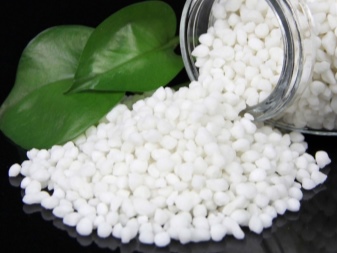
Mineral complexes include nitroammofoska, which contains phosphorus, potassium and nitrogen, 16 percent each. This complex is also diluted with 10 liters of water, which accounts for approximately 20-30 grams of mineral supplements. Each bush takes about five liters of this solution. Diammofoska is another mineral complex, which contains 26 percent of phosphorus and potassium, but only 10 percent of nitrogen. There are only 10 grams of this additive for ten liters of water.
The next subgroup of additives is phosphorus-potassium. The largest part of this complex falls on phosphorus and potassium, and only a small part is diverted to nitrogen. Therefore, this supplement is suitable for the period of bud formation and flowering. These include superphosphate, which has the highest phosphorus concentration of 2–30 percent and only 6–9% nitrogen. For 10 liters of water, there are 10–20 grams of this additive.
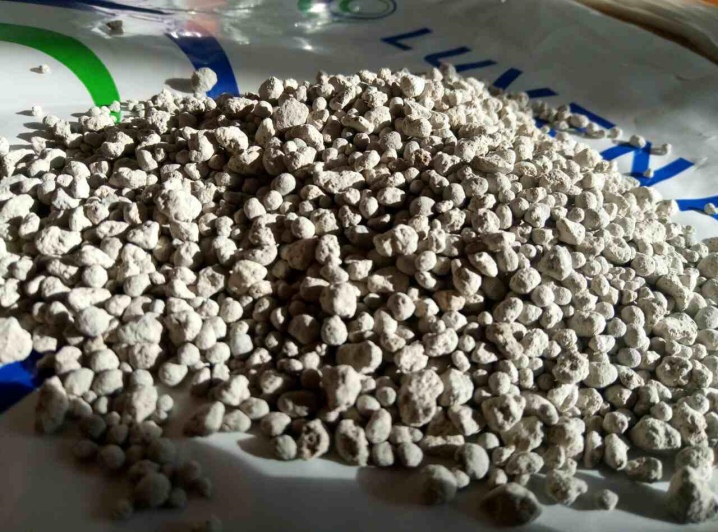
There is also double superphosphate, the phosphorus content of which is as much as 46 percent, but nitrogen is not more than 10 percent. If you decide to use double superphosphate, then the dosage should be reduced by 2 times, that is, by 10 liters, you need to add only 5-10 grams. Potassium sulphate contains the most concentrated potassium mixture at 46 to 52 percent. For 10 liters of water, you need to add only 10–20 grams of sulfate. But it is best to use potassium magnesium, which, together with potassium, contains magnesium, which is responsible for the rich color of already opened buds.
If there are some problems with the soil, for example, insufficient acidity, leading to a problem with the assimilation of useful elements from fertilizing, it is recommended to use humates. They help the plant absorb fertilizers better.
You can draw up a special feeding scheme, which will include a suitable complex of mineral fertilizers, then the necessary phosphorus-potassium supplement (superphosphate or potassium magnesium). Selected additives must be poured with humate in the proportions indicated in the instructions, and root top dressing with the resulting solution must be carried out.

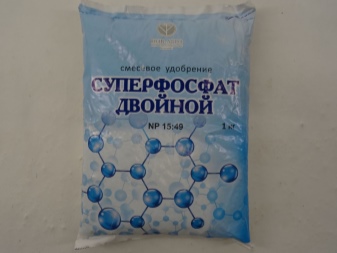
For the first feeding, use potassium sulfate and urea. You will need one tablespoon of each supplement, which must be filled with ten liters of warm water. However, this mixture is enough for only two plants, since in order for the plant to obtain the required amount of nutrients, you must spend at least five liters on watering one bush. Before budding and flowering, it is necessary to transfer the plant to other top dressing containing elements more suitable for that period. Any phosphate-potassium fertilizer will do.They are quite easy to use, since any of them is filled with 10 liters of warm water without additional dilutions and additives.
In summer, you should give preference to organic fertilizers. One of the most suitable is nettle infusion. It is great for hot summer, when using it there is no danger of overloading the soil and the plant, but the concentration of nutrients in the nettle solution is several times less than that of industrial fertilizers. The infusion is done in two stages - first a concentrated solution, and immediately before watering - a solution diluted in a bucket of plain water. After using the nettle infusion, it is worth spilling the hydrangeas with an additional bucket of clean water without additives.
During the ripening and opening of the buds, for a longer flowering period, such fertilizing as, for example, "Kemira Tsvetochnaya" is used. There is only one tablespoon of this product for 10 liters of water, so its consumption will be quite economical.

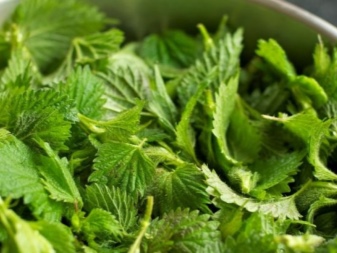


How to fertilize a hydrangea before flowering, see below.



































































The comment was sent successfully.